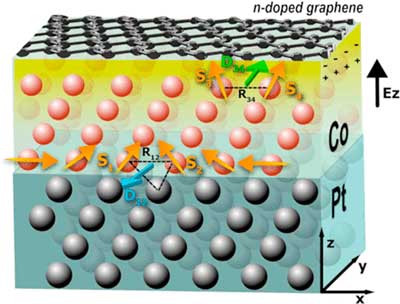| Mar 11, 2019 | |
Graphene and cobalt team up in new electromagnetic devices(Nanowerk News) Spin-orbitronic is one of the latest technologies to encode digital information. This technology, which provides high processing speed, high capacity for data storage, and very low energy consumption, can be applied in certain materials to generate magnetic configurations that are very stable, but can still be controlled and moved quickly with small electrical currents. |
|
| Now, a team led by Graphene Flagship partner IMDEA Nanociencia has developed a new methodology to prepare graphene spin-orbitronic systems. The resulting structures are considered very promising for future 'spin-orbitronic' storage devices. | |
| Spin-orbitronic exploits both the charge of the electron (electronics) and its spin (spintronics) and the interaction of the spin with its orbital motion, offering a multitude of properties that are relevant to magnetism. | |
| The new devices are made of graphene films – a single atom thick graphite layer – placed on ferromagnetic material: cobalt, arranged around a platinum layer with a certain crystallographic orientation. The results were recently published in Nano Letters ("Unraveling Dzyaloshinskii–Moriya Interaction and Chiral Nature of Graphene/Cobalt Interface"). | |
| Paolo Perna, lead author of the study from Graphene Flagship partner IMDEA Nanociencia, explains the advantages of the cobalt-graphene symbiosis: "On one hand, the exceptional properties of graphene allow us to obtain a homogeneous, flat and protected magnetic layer, which is also atomically perfect. However, what matters most," he goes on to emphasize, "we achieve two key magnetic properties: an improvement in the magnetic anisotropy of cobalt – its spins are preferably oriented in a certain direction – and a strong interaction called Dzyaloshinskii-Moriya, which allows the presence of chiral magnetic structures – which do not overlap with its specular image." | |
 |
|
| Diagram of stacked graphene, cobalt (Co) and platinum (Pt) layers with magnetic interaction vectors. (Image: Adrián Gudín, Paolo Perna, IMDEA Nanociencia, (© American Chemical Society) | |
Skyrmions for carrying binary information |
|
| These nanometric chiral magnetic structures are called skyrmions, are very stable and act as carriers of binary information as they travel through the channel proposed by the authors: graphene. | |
| "By passing through two electrical contacts, each skyrmion produces a change in the electrical response that can be decoded into zeros and ones," explains Perna. "In this way, in the near future it will be possible to produce spin-orbitronic magnetic devices, such as magnetic memories or sensors that are much faster and denser than the current ones, and specially allowing much lower energy consumption," the researcher stresses. | |
| In order to detect the properties of the new devices, the authors combined spectroscopy and microscopy techniques, including light beams at the ALBA synchrotron near Barcelona, Spain. As the basis of the device, the authors used oxide insulating substrates. In order to obtain high-quality graphene, metallic substrates are usually used in laboratories, they do not allow the electrical insulation of the device. | |
| "We have proven that it is possible to prepare high quality magnetic structures based on graphene and on oxide insulating substrates, which can be implemented in current manufacturing processes," Perna notes. | |
| This work was performed within the framework of the Graphene Flagship European initiative, as part of the SOgraphene Partnering Project of the Flagship, coordinated by Professor Rodolfo Miranda of IMDEA Nanociencia and involving Albert Fert, 2007 Nobel Prize in Physics, and his team from the Unité Mixte de Physique CNRS/THALES, as well as researchers from the SOLEIL synchrotron in France and the PM institute in Italy. |
| Source: By Enrique Sacristán, SINC | |
|
Subscribe to a free copy of one of our daily Nanowerk Newsletter Email Digests with a compilation of all of the day's news. |
